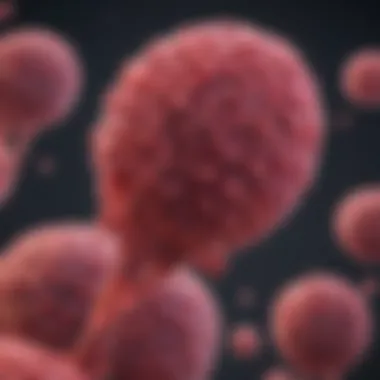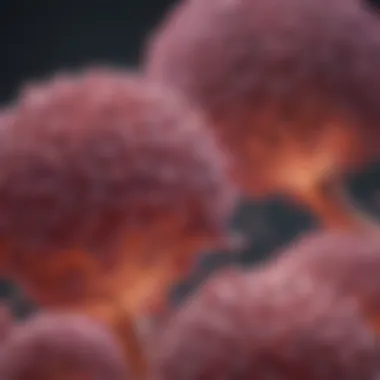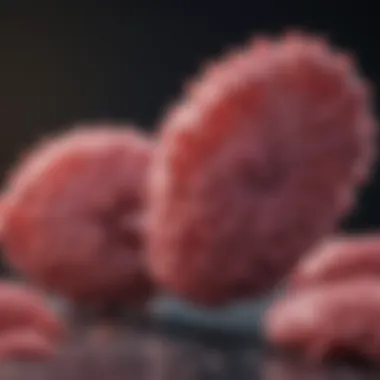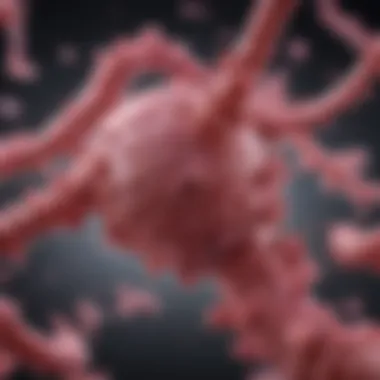Understanding PI3KCA's Role in Breast Cancer


Intro
The PI3KCA gene holds a significant position when discussing breast cancer pathogenesis, embodying both a critical driver of tumor growth and a potential target for cutting-edge therapies. Understanding how mutations in this gene influence cancer progression is essential for anyone involved in oncology. As such, exploring PI3KCA not only aids in recognizing the biological mechanisms at play but also sets a course for improved patient treatment strategies.
Overview of Research Topic
Brief Background and Context
Breast cancer is not a monolith; it harbors various subtypes and genetic variations that dictate its behavior and response to treatment. Among the influential genes is PI3KCA, which encodes a component of the phosphoinositide 3-kinase (PI3K) pathway, a key player in cell growth, proliferation, and survival. Mutations in PI3KCA have emerged as markers suggesting a specific cancer profile. Around 30% of breast cancer patients exhibit these mutations, creating a substantial body of evidence that underscores their relevance in clinical oncology.
Importance in Current Scientific Landscape
The exploration of PI3KCA mutations has far-reaching implications. Its presence in breast cancer not only signifies an alteration in traditional therapeutic responses but also allows us to contemplate personalized medicine approaches. Researchers are scrambling to discern how PI3KCA impacts existing oncogenic pathways, thus shaping more targeted treatments for those affected. Oncology is often painted as a vast sea of uncertainties, yet with each discovery about this gene, we inch closer to deciphering its profound implications in patient care, paving the way for tailored therapeutics that are sorely needed in modern medicine.
Methodology
Research Design and Approach
This article deploys a comprehensive review methodology, synthesizing existing literature, recent studies, and clinical trials focused on PI3KCA mutations. The aim is to collate valuable insights from diverse sources, thus illuminating the multifaceted role this gene plays in breast cancer development and treatment strategies.
Data Collection Techniques
Data collection involved a thorough examination of both primary studies and meta-analyses from leading journals in oncology and genetics. Online databases such as PubMed and Google Scholar serve as resource centers, allowing for the extraction of relevant articles that outline the mutation profiles and their correlation with various treatment outcomes.
Additionally, case studies that exemplify the significance of PI3KCA mutations in clinical scenarios were reviewed, enriching the overall understanding of its impact in healthcare settings. Through this systematic approach, we aim to construct a well-rounded perspective on how these genetic alterations can influence patient management in breast cancer.
Preface to PI3KCA
Understanding the role of PI3KCA in breast cancer is imperative for those vested in oncology's evolving landscape. The PI3KCA gene encodes a protein involved in crucial cellular functions, including growth, proliferation, and survival. As a common driver of cancer, its mutations present significant implications for breast cancer's pathogenesis and potential treatment strategies.
The exploration of PI3KCA is particularly relevant due to its high mutation rate in breast cancer patients, which can lead to varied responses to therapies. By grasping the complexities of this gene, researchers and clinicians can better comprehend how it affects tumor development and progression, ultimately shaping individual treatment decisions. As this article unfolds, we will delve into the various aspects of PI3KCA, spotlighting its biological and clinical significance in the context of breast cancer.
Nature and Function of PI3KCA
PI3KCA operates within the phosphoinositide 3-kinase (PI3K) signaling pathway. This pathway is vital for transmitting signals from outside the cell, regulating several fundamental cellular processes. When activated, PI3KCA ultimately influences processes like metabolism, cell cycle progression, and apoptosis—functions essential for normal cellular activity as well as for oncogenesis.
Mutations in the PI3KCA gene can lead to abnormal activation of the PI3K pathway, pushing cells toward uncontrolled growth and survival. These gain-of-function mutations often result in a constitutive activation of downstream signaling pathways like AKT, which contributes to cancer cell proliferation and resistance to apoptosis.
The nature of these mutations is diverse; some may replace a single amino acid, while others might lead to a structural alteration of the protein. This variance affects not only the functionality of the protein but also how tumors respond to targeted therapies.
PI3K Pathway Overview
The PI3K pathway comprises a network of interactions beginning with the receptor tyrosine kinases, which, when activated by growth factors, recruit PI3K. This initiates a cascade of signaling events that are critical for the survival and growth of cancer cells. Here’s a simplified breakdown of its working:
- Receptor Activation: Growth factors bind to their specific receptors on the cell surface, triggering a reaction.
- PI3K Activation: This binding activates PI3K, which then phosphorylates the inositol lipids in the cell membrane.
- Production of PIP3: The conversion of phosphatidylinositol (4,5)-bisphosphate (PIP2) to phosphatidylinositol (3,4,5)-trisphosphate (PIP3) is crucial, as it creates a docking site for downstream signaling proteins.
- Activation of AKT: The accumulation of PIP3 invites AKT to the membrane, where it becomes activated, triggering a plethora of downstream effects that promote cell survival, growth, and proliferation.
Thus, interference at any point along this pathway can either quell tumor growth or, conversely, enable it. Consequently, understanding PI3KCA mutations provides insight into potential therapeutic targets for more effective breast cancer treatments.
PI3KCA and Breast Cancer


Breast cancer represents a significant public health concern globally, with multiple factors contributing to its pathogenesis. One of the most critical players in the game is the PI3KCA gene, which has garnered considerable attention in recent years. Mutations in PI3KCA are frequently observed in a subset of breast cancer cases, making it a pivotal element in both the understanding and treatment of this complex disease.
In this section, we will dig into the prevalence of PI3KCA mutations within breast cancer and explore the mechanisms by which these mutations lead to tumorigenesis. Understanding this relationship is crucial for developing targeted therapies that may significantly improve patient outcomes.
Prevalence of PI3KCA Mutations in Breast Cancer
PI3KCA mutations are not rare in the realm of breast cancer. Studies indicate that around 30-40% of breast cancer patients exhibit mutations in this gene. What’s even more striking is the tendency for these mutations to be more frequent in specific subtypes of breast cancer, such as hormone receptor-positive (HR+) and HER2-positive cases. This prevalence raises pertinent questions: Why does PI3KCA become a target for mutation when the stakes are already high in breast cancer?
Several environmental and biological factors may play a role. Hormonal influences, particularly estrogen, have been implicated in the stimulation of PI3KCA mutations. The significance of this mutation's prevalence cannot be understated—its understanding can inform both prognosis and therapy. In patients harboring these mutations, there often exists a distinct set of clinical features, which may guide clinicians in tailoring therapeutic approaches.
- Key Points:
- Mutation Frequency: 30-40% in breast cancer patients.
- Subtypes Affected: Primarily hormone receptor-positive and HER2-positive cancers.
- Implications: Can impact prognosis and pave the way for targeted treatments.
Mechanisms of Tumorigenesis
How does a mere mutation in the PI3KCA gene lead to the chaotic proliferation of cells we recognize as cancer? To answer this question, one must peer into the molecular level of cell signaling intricacies. The PI3K protein plays a vital role in numerous cellular functions, including growth, survival, and metabolism.
Mutations in PI3KCA typically result in its activation, leading to a cascade of downstream signaling events, notably through the AKT pathway. When activated, the PI3K signaling pathway enhances cell survival and proliferation while inhibiting apoptosis, the programmed cell death that serves as a natural guardian against tumor development. Consequently, this aberrant signaling fosters an environment conducive to tumor growth and spread.
“Mutations in PI3KCA set off a biochemical chain reaction, fostering an environment ripe for tumorigenesis.”
The interactions between PI3KCA mutations and other oncogenic pathways, such as those driven by the RAS or HER2, can amplify the effects of these mutations, pushing breast cancer cells further down the pathway of malignancy.
- Mechanistic Insights:
- Cell Proliferation: PI3K signaling promotes rapid growth.
- Survival Advantages: Inhibition of apoptosis leads to prolonged cell life.
- Pathway Interactions: Synergy with RAS/HER2 pathways elevates tumorigenic potential.
In summary, the connection between PI3KCA mutations and breast cancer is rooted in a complex web of interactions that enhance cell growth and survival. This understanding is pivotal for the development of therapeutic strategies that target this specific genetic alteration, potentially improving patient care in breast cancer management.
Biological Implications of PI3KCA Mutations
PI3KCA mutations play a significant role in the biological landscape of breast cancer. Understanding these implications is crucial, as they not only inform us about tumor behavior but also influence treatment options for patients. The feedback loop between molecular alterations and tumor development is intricate. Thus, a clear comprehension of how PI3KCA mutations affect cellular processes can lead to new strategies for targeting breast cancer more effectively.
Effects on Cell Growth and Survival
PI3KCA mutations often lead to persistent activation of the phosphoinositide 3-kinase (PI3K) pathway, which is critical for cell growth and survival. Normally, this pathway is tightly regulated, controlling various cellular functions including metabolism and proliferation. However, when mutations occur, such as the common E545K and 047R mutations, they can cause a loss of this regulated control, resulting in unchecked cellular proliferation.
The ramifications of these mutations can be severe. For instance, studies have shown that breast cancer cells harboring PI3KCA mutations often demonstrate increased resistance to apoptosis, which is the programmed cell death that the body uses to eliminate damaged cells. Instead of dying off, these cells continue to divide and accumulate, forming tumors that can become aggressive.
In essence, the point mutations lead not just to growth advantage but also set the stage for tumor progression. Monitoring these mutations can provide vital insights into the aggressiveness of the cancer, enabling tailored treatment approaches.
Interaction with Other Oncogenic Pathways
The interplay between PI3KCA mutations and other signaling pathways adds another layer of complexity to breast cancer biology. These mutations do not act in isolation; instead, they often collaborate with alterations in other oncogenes and tumor suppressor genes, such as HER2 and PTEN.
For example, when PI3K signaling is activated due to a mutation, it may work in concert with overexpression of HER2, a receptor tyrosine kinase commonly found in aggressive breast cancers. This synergistic interaction can result in enhanced tumorigenic potential, making the cancer more difficult to target therapeutically.
Moreover, the cross-talk between PI3K and other pathways, like the MAPK pathway, can lead to compensatory mechanisms that foster resilience in cancer cells. This may drive a scenario where targeting only the PI3K pathway might not suffice to control tumor progression, necessitating an integrated approach that involves combination therapies. Some researchers advocate for simultaneous targeting of the PI3K pathway and its interlinked signaling networks to overcome resistance and improve treatment outcomes.


"Understanding these dynamic interactions among pathways will be key in devising effective therapeutic strategies against breast cancer with PI3KCA mutations."
In summary, the biological implications of PI3KCA mutations are profound and multifaceted, influencing cell growth, survival, and interactions with other oncogenic pathways. Elucidating these mechanisms is essential as it lays the groundwork for advancing treatment modalities and furthering personalized medicine in the fight against breast cancer.
Clinical Significance of PI3KCA in Breast Cancer
The exploration of PI3KCA in the context of breast cancer extends beyond the shadows of genetic mutations into the realm of clinical applicability. Understanding the role of this gene can pave the way for precision treatments, making it a cornerstone in ongoing cancer research. By dissecting its significance as a prognostic marker and its implications for treatment strategies, we gain insights into how to personalize therapeutic approaches for breast cancer patients.
Targeting PI3KCA in Therapy
The targeting of PI3KCA in breast cancer therapy shines a light on a crucial aspect of modern oncology. PI3KCA mutations play a significant role in the progression of breast cancer, and thus, they present an opportunity for tailored treatment approaches. By focusing on PI3KCA, researchers and clinicians can develop strategies that are not only innovative but also directly aligned with the unique biology of the tumors they are treating. In doing so, they enhance the precision of therapeutic interventions, which could lead to improved patient outcomes.
Development of PI3K Inhibitors
In the pursuit of effective treatments, the development of PI3K inhibitors has emerged as a promising strategy. These inhibitors specifically target the PI3K pathway, which is often disrupted in breast cancers harboring PI3KCA mutations. For example, drugs like alpelisib have been designed to specifically inhibit the alpha isoform of PI3K, thus blocking the oncogenic signaling that drives tumor growth and survival.
The journey to these inhibitors commenced with extensive research into the PI3K pathway itself. It was found that inhibiting this pathway can reduce the growth and invasiveness of tumor cells. Moreover, these inhibitors are potentially more effective when combined with other treatment modalities, such as hormonal therapies or chemotherapy, considering that many patients with breast cancer have tumors that display multiple mutations.
The development phase of these inhibitors involved rigorous clinical trials, which demonstrated not only their efficacy but also highlighted their acceptable safety profiles. As more is learned about the specific mutations in patients’ tumors, these inhibitors can be further refined to optimize their benefits.
Clinical Trials and Outcomes
Clinical trials focused on PI3K inhibitors are paving the way for breakthroughs in targeted cancer therapy. Some trials have yielded promising results, showcasing the capability of these drugs to decrease tumor size significantly or, in some cases, lead to complete responses in specific patient populations.
For instance, the results from trials indicating the success of alpelisib in combination with letrozole underline a pivotal shift in treatment paradigms. Patients with advanced breast cancer and PI3K mutations showed notable improvements in progression-free survival when treated with this combination compared to standard therapies.
However, it’s important to note that while these outcomes are promising, not all patients respond equally. Resistance mechanisms to PI3K inhibitors have been observed, driving home the point that ongoing research is essential. Understanding these responses and adapting strategies accordingly is key for future clinical applications.
"The success of PI3K inhibitors in clinical trials underscores the importance of understanding tumor genetics to tailor therapies effectively."
With continued exploration of PI3K inhibitors, there lies the potential to refine and improve treatment strategies for breast cancer, ultimately progressing towards more personalized and effective patient care. The landscape of breast cancer treatment is evolving, and understanding the role of PI3KCA in this journey is fundamental.
Resistance Mechanisms to PI3K Targeting
In the context of breast cancer treatment, understanding the resistance mechanisms to PI3K targeting is crucial. The PI3KCA mutation often centralizes therapy efforts, as drugs aiming to inhibit this pathway have emerged. Nevertheless, resistance mechanisms can thwart these therapeutic approaches, posing a significant challenge to clinicians and researchers alike.
Such resistance can stem from various biological adaptations, and it’s imperative that we dissect these elements to better inform treatment strategies. In recent years, the identification of these mechanisms has not only illuminated the dark corners of treatment failure but has also opened doors for potential therapeutic combinations.
Overview of Resistance in Targeted Therapies
The landscape of targeted therapies is not as straightforward as one might imagine. Despite the advancements in understanding PI3KCA and its role, resistance frequently arises, risking the efficacy of these treatments. Commonly, tumors develop resistance through genetic variation or activation of alternative signaling pathways.
Here are some avenues of resistance observed in clinical settings:
- Genetic Mutations: Tumors may acquire secondary mutations that allow them to bypass the inhibited PI3K pathway, continuing to thrive despite treatment.
- Feedback Activation: When a specific pathway is inhibited, cells can sometimes initiate compensatory mechanisms. For instance, if the PI3K pathway is blocked, cells may upregulate alternative pathways, like ERK, which can support tumor survival and growth.
- Microenvironmental Factors: The tumor's microenvironment can play a role. Surrounding cells can sometimes contribute to treatment failure by secreting factors that activate signaling pathways in cancer cells, rendering targeted therapies ineffective.
Addressing these mechanisms is vital for the continuing evolution of personalized therapy in breast cancer. As researchers unravel these layers of complexity, it will become easier to devise combinations of therapies that might circumvent these resistance mechanisms.
Alternative Pathways and Adaptations


The reliance on the PI3K pathway in cancer progression is evidently significant, but when targeted, tumors often seek refuge through alternative pathways. This adaptability underlines the resilience of cancer cells.
Notably, several alternative pathways have been implicated:
- MAPK Pathway Activation: The Mitogen-Activated Protein Kinase (MAPK) pathway can serve as an alternative signaling route, essentially bypassing the effects of PI3K inhibition. Cancer cells can engage this pathway, thus sustaining their growth even when the PI3K pathway is compromised.
- mTOR Signaling: Inhibition of PI3K often leads to hyperactivation of mTOR signaling, which can promote growth and survival independently of PI3K. Some tumors leverage this relationship to resist therapy.
- Possibility of Novel Mutations: The ever-evolving nature of tumor genetics means that resistance can also involve the emergence of novel mutations that create alternative signaling mechanisms.
In summary, understanding the nuanced resistance mechanisms to PI3K targeting not only aids in recognizing potential hurdles but also inspires innovative treatment paradigms.
"The path of least resistance is what makes rivers and men crooked."
Incorporating this wisdom into oncology might pave the way for breakthroughs in how we address resistance, refining our arsenal against breast cancer by adapting to the challenges at hand.
Future Directions in Research
The exploration of PI3KCA's role in breast cancer is not just a current endeavor; it sets the stage for the future of oncological research. Understanding the nuances of this gene can lead to breakthroughs in how breast cancer is approached, treated, and ultimately, managed. The emphasis on future directions in this field lies in several key areas, each holding potential to reshape our understanding and treatment of breast cancer.
Emerging Therapeutic Strategies
In the quest for targeted therapies, emerging strategies focus on refining how we approach PI3KCA mutations. Given that these mutations maintain a substantial role in tumorigenesis, developers are investigating new inhibitors that can selectively target PI3KCA and associated pathways.
- Dual-target therapies are becoming a focal point, where researchers are combining PI3K inhibitors with agents that target other pathways, such as HER2 or AKT, which may overcome resistance mechanisms often seen in monotherapies.
- Novel compounds, currently under investigation, aim to improve specificity and reduce off-target effects. These inhibitors might help in minimizing side effects and increasing patient compliance.
- Biomarker-guided approaches could tailor treatment based on individual patient profiles. For instance, identifying specific mutations within PI3KCA may lead to customized therapy regimens that are more effective.
This emerging landscape not only harbors the promise of new treatment options but also emphasizes how important it is to keep pace with the rapid advancements in molecular biology and pharmacology. Integrating cutting-edge technologies, like CRISPR and next-generation sequencing, could further enhance our understanding of treatment efficacy and patient outcomes.
The Role of Personalized Medicine
Amidst the evolving treatments, personalized medicine stands out as a game-changer in breast cancer management. By tailoring therapies to individual genetic profiles, especially concerning PI3KCA mutations, healthcare providers can significantly affect treatment outcomes.
A few noteworthy considerations include:
- Tailored treatment plans are designed based on the mutation spectrum of an individual patient. For example, patients with specific PI3KCA mutations might benefit from certain inhibitors that are more effective against those mutated pathways than traditional chemotherapy.
- Monitoring patient response to treatment is now more precise, facilitating real-time adjustments to therapy as necessary, thereby increasing the likelihood of achieving desired outcomes.
- Patient involvement grows in significance, as education around the implications of their genetic profiles empowers patients to take an active role in their treatment decisions.
In summary, the future of breast cancer research, particularly regarding PI3KCA, is vibrant and full of potential. The integration of emerging therapeutic strategies and the principles of personalized medicine hold the key to effectively transforming how this disease is treated, providing hope for improved patient outcomes in a field that is constantly advancing.
“Exploring the nuances of PI3KCA mutations opens new avenues for breast cancer treatment, enabling tailored strategies that speak directly to the individual biology of tumors.”
Research continues to burgeon, and advancements will remain paramount to ensure that patients receive the most effective and efficient care possible.
Ending
In reflecting on the role of PI3KCA mutations in breast cancer, it's clear that this gene is not just another player in the field, but rather a significant piece of the puzzle that influences disease prognosis and therapeutic strategies. Understanding the intricate biology underlying these mutations is crucial for both researchers and clinicians alike.
Summary of Findings
The analysis throughout this article highlights several key insights:
- Prevalence of Mutations: PI3KCA mutations are among the most commonly occurring genetic alterations in breast cancer, affecting a substantial subset of patients. Their recurrent nature suggests a robust role in the development and progression of the disease.
- Tumorigenesis Mechanisms: The activation of the PI3K/AKT pathway due to these mutations can lead to increased cell proliferation and survival, highlighting the mutation's critical role in oncogenesis.
- Clinical Implications: PI3KCA serves as a prognostic marker, offering clinicians valuable information to tailor treatment plans. This is particularly important as therapies aimed at inhibiting the PI3K pathway are being developed and tested.
- Future Directions: Personalized medicine is emerging as a vital approach in breast cancer treatment, with PI3KCA mutations serving as a potential cornerstone for developing individualized therapy regimens.
These findings underscore the multifaceted influence PI3KCA mutations have not only on disease biology but also on the development of clinical strategies aimed at improving patient outcomes.
Implications for Future Breast Cancer Management
As research advances, the implications of PI3KCA mutations for breast cancer management continue to evolve. Notably, several areas warrant attention:
- Implementation of Targeted Therapies: The development of PI3K inhibitors, such as alpelisib, represents a new frontier. These therapeutics specifically aim to counteract the effects of PI3KCA mutations, potentially improving survivorship rates. Studies have shown promise in combining these inhibitors with other treatments, which could enhance efficacy and reduce resistance.
- Role of Biomarkers in Treatment Selection: The incorporation of PI3KCA mutation status into routine testing can significantly influence treatment decisions. For patients with these mutations, clinicians might prioritize therapies designed to inhibit the PI3K pathway or tailor chemotherapy regimens accordingly.
- Personalization of Care: As we embrace personalized medicine, the combination of genetic profiling and advanced therapeutic strategies will likely lead to more effective and individualized treatment plans. Moreover, ongoing research into resistance mechanisms will be essential as it can inform strategies to circumvent treatment failures.
In summary, understanding the implications and applications of PI3KCA mutations in breast cancer not only enhances our current therapeutic landscape but also sets the stage for future breakthroughs that could alter the course of this disease for countless patients.



